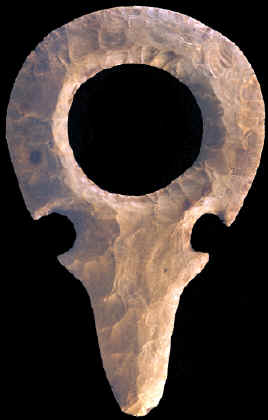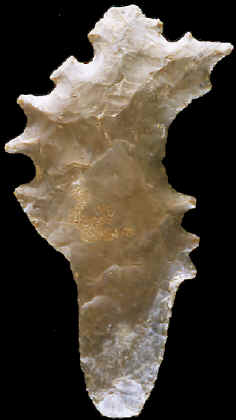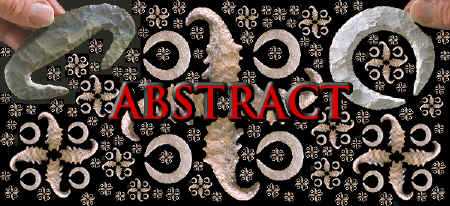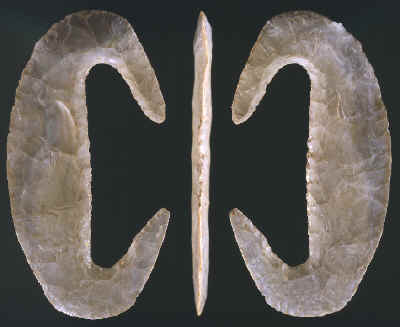|
"Perhaps
the finest examples of this craft (flintknapping) that have come down to
us are the exceedingly elaborate yet delicately chipped heads (Maya
eccentrics) for ceremonial staffs"-----1946,
Sylvanus G. Morely.
"Eccentric flints
are chipped flint objects of unusual, essentially non-utilitarian
forms."------1972,
Gordon R. Willey
"Eccentrics
are large bifaces or macro-blades whose shapes conform to one of several
symbol designs."------1991, Harry J.
Shafer.
"Chipped
stone eccentrics, or symbolic-shaped stone artifacts, were one of the
items manufactured in the Colha (Belize) workshops. These items were not
used in daily life, but were used in ritual events."------1997, Harry J.
Shafer & Thomas R. Hester.
|
 
CLICK ON LEFT
PICTURE FOR LARGE IMAGE
MAYAN ECCENTRICS
FROM BELIZE
FLOYD
RITTER COLLECTION
These two eccentrics are larger than most examples. The one on the
left is the larger of the two. It was found in northeastern
Belize near the town of Altun Ha on a site also by that name.
Elaborate perforated examples like this one have been discovered
on other Maya sites. Variations on this design have extra notches on the edge and a wavy serpentine handle. This one is
thin and very well flaked. It measures 8 1/8 inches (20.7 cm) long.
The eccentric on the right is a couple of inches smaller and not
quite as well flaked.
Both of these eccentrics have one thing in common
and that is the stem or handle. Eccentrics that are large enough to
be mounted onto staffs and have "stems" like these two examples
are sometimes referred to as staff-heads. |
|
"But the most exciting of all were nine
"eccentric flints."----"Eccentric
flints represent one of the rarest art forms of ancient Mesoamerica."-1991,
William L. Fash, Ricardo Agurcia Fasquelle. (National Geographic Mag., Sept., 1991)

MAYAN
ECCENTRIC FLINTS
The most spectacular discovery of Maya culture eccentrics ever found happened
in 1989 by archaeologists William Fash and Ricardo
Fasquelle. They made the discovery right at the end of their field season.
During their excavation, while tunneling into a Maya temple
pyramid on the Copan site in Honduras, they found a smaller temple buried
within. In the temple's first chamber they found, ceremonial offerings of chert knives, a jade bead, sea shells and shark vertebras,
and an extraordinary cache of nine very large eccentric flints
(see
Sept. 1991 issue of National Geographics pp. 94-103).
They are by far
the best Mayan eccentrics ever found during a
scientific excavation. They are in fact some of the most skillfully made chipped
stone artifacts ever found in the world. The human-like forms range in size to
approximately 18inches (46 cm) or more in length and may represent or correspond
to the nine divine Maya lords of the night. They date to around 600 A.D.
|
|
"REFERENCES"
1946,
"The Ancient Maya," by Sylvanus G. Morley, page 436.
1965, "Prehistoric Maya Settlements in the Belize Valley," by
Gordon R. Willey, William R. Bullard, john B. Glass & James C. Gifford,
pp. 25-28, 421, 445-452.
1971,
"The Maya," by Michael D. Coe, pp.149-150.
1972,
"The Artifacts of Altar De Sacrificios," by Gordon R. Willey,
pp181-219.
1972, "Excavations At Altar De Sacrificios," by A.
Ledyard Smith, pp. 110-113, 204-211.
1978, "Teotihuacan, Tepeapulco, & Obsidian Exploitation," Science
200, by Thomas H. Charlton, pp. 1227-1236
1983, "Pulltrouser Swamp," Ancient Maya Habitat,
Agriculture, and Settlement in Northern Belize, 12. The Lithic
Artifacts of the Pulltrouser Area: Settlements and Fields, by Harry
J. Shafer, pp. 219-120.
1984, "Exploitation of Chert Resources by the Ancient Maya of Northern
Belize, Central America," World Archaeology Vol. 16 No. 2, by
Thomas R. Hester and Harry J. Shafer, pp. 157- 170.
1984, "Cenote of Sacrifice," edited by C. Chase Coggins
& Orrin C. Shane.
1991, "Maya Artistry Unearthed," National Geographic, Sept.
1991, by William L. Fash, Jr. and Ricardo Agurcia Fasquelle, pp. 94-105.
1991, "Maya Stone Tools," Selected Papers from the Second
Maya Lithic Conference, The Flaked Cert Industry of Tikal,
Guatemala, by Hattula Moholy-Nagy, pp., 197-199.
1991, "Maya Stone Tools," Selected Papers from the Second
Maya Lithic Conference, Late Preclassic Formal Tool Production at
Colha, Belize, by Harry J. Shafer pp. 31 & 38.
1991, "Maya Stone Tools," Selected Papers from the Second
Maya Lithic Conference, Lithic Artifacts From Cerros, Belize:
Production, Consumption, and Trade, by Beverly A. Mitchum pp.
45.
1991, "Maya Stone Tools," Selected Papers from the Second
Maya Lithic Conference, "Structure and Dynamics of
Intercommunity Exchange." by Patricia A. McAnany, pp.
271-272.
1993, "Elites, Eccentrics, and Empowerment in the Maya
Area:" by Gyles Iannone & James M. Conlon, pp. 3-5.
1996, "The Oxford Companion To Archaeology", by Brian M.
Fagan,
pp. 406-415.
1997, "Craftsmen to the Kings," Rural Maya Stone
Technology at Colha, Belize by Dr.
Harry
J. Shafer & Dr. Thomas R. Hester, page 6.
1998, "Investigations at Piedras Negras, Guatemala: 1998 Field
Season," by Stephen D. Houston, pp. 1& 2.
2001, "Northern Yucatan Obsidian Finds - Merida and Chichen
Itza," Foundation for the Advancement of Mesoamerican Studies,
Inc., by Geoffrey E. Braswell, p. 1.
|





